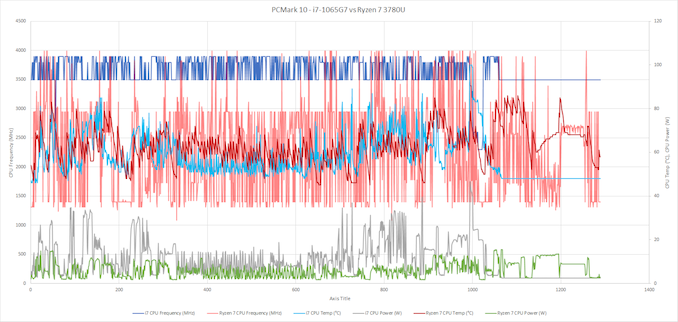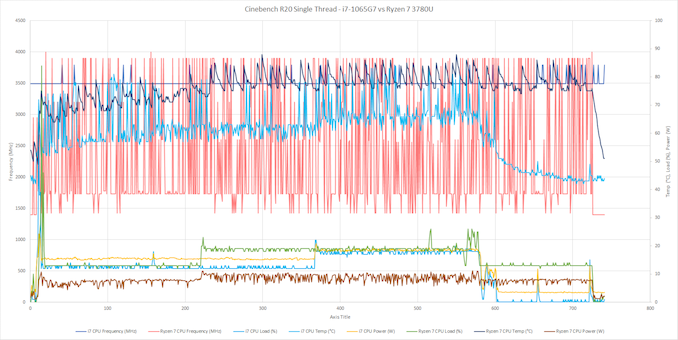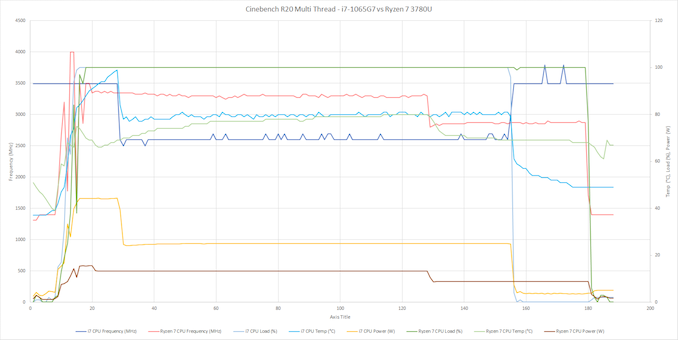The Microsoft Surface Laptop 3 Showdown: AMD's Ryzen Picasso vs. Intel's Ice Lake
by Brett Howse & Andrei Frumusanu on December 13, 2019 8:30 AM ESTBenchmark Analysis: Boost Behavior
Let’s dig into some of the testing to see how the systems responded during the benchmarks. We re-ran several of the tests while simultaneously monitoring the processor frequency, temperature, and power. Unfortunately for our comparison, the power polling results provided by our monitoring tools don’t seem to monitor the same power draw. The Intel power numbers are for the SoC package, but the AMD power numbers appear to be just the CPU cores, which is an unfortunate byproduct of testing two different platforms.
PCMark 10
PCMark 10 is a benchmark platform that attempts to simulate real-world tasks by running a variety of workflow, and the results were perhaps the most interesting of any of the benchmarks. There is a major discrepancy in how the AMD CPU behaved compared to the Intel. The Ice Lake platform kept the CPU frequency at a minimum of 3.5 GHz, with bursts to 3.9 GHz when under load. The Picasso processor was very aggressively switching from low frequency to high frequency, and was rarely indicating that it was over 3.0 GHz, but clearly demonstrating its higher peak frequency of 4.0 GHz in several locations. Both systems were fairly even in terms of CPU temperature, and Intel’s aggressive turbo levels were evident with peak power levels of 40 Watts for brief moments. The Ice Lake platform finished the benchmark about 200 seconds quicker than the Picasso system.
Cinebench R20 Single-Thread
We see somewhat similar results when only a single CPU core is loaded with the Picasso CPU frequency varying quite a bit. There’s also an average higher temperature on the AMD platform during this workload, and once again Ice Lake finishes the rendering quite a bit sooner thanks to its stronger CPU cores.
Cinebench R20 Multi-Thread
With all cores loaded the graph is considerably altered. Here the AMD processor is able to maintain a much higher frequency across its cores for much longer, while Intel's chip is only able to maintain 3.5 GHz for about 30 seconds before it runs out of headroom, dropping the cores down to around 2.6 GHz. But despite the lower frequency, the much higher IPC on Sunny Cove allows the Ice Lake platform to finish quite a bit sooner.













174 Comments
View All Comments
Korguz - Friday, December 20, 2019 - link
HStewart.. and yet to STILL believe the lies intel tells you.. that is why you are thought of as an intel fanboy... until intel delivers on what they claim, and actually have products out, and no, the limited products on 10nm, that max out at quad core and lower frequencies then 14, does NOT count, anything they say, should be treated as BS...going by your post.. you have NO proof of your claims... and they are in fact, just your opinions...
MBarton - Monday, December 30, 2019 - link
At this point Intel's roadmaps are nothing more than lip service for investors. Absolutely nobody takes them seriously.djayjp - Friday, December 13, 2019 - link
AMD should've led Zen 2 (third gen Ryzen) with mobile first. Oh well maybe next generation.djayjp - Friday, December 13, 2019 - link
Also the marketing name for the chips really doesn't help, in fact I think it works against them and makes them look bad.ChubChub - Sunday, December 15, 2019 - link
Absolutely this. A friend's 6600k just died, and wanted to go with AMD. I'm up to date with most computer stuff, so he asked my opinion.He was thinking a 3400g,because APU + 3rd gen Ryzen. It was weird to tell him that AMD stupidly named the 1st gen APUs with the 2nd gen nomenclature … then continued this stupidity for no reason. All chips 1xxx are Zen, all 2xxx chips are Zen+, all 3xxx chips are ZEN 2 … well, except the APUs, which are all back a generation.
I have high hopes for the 4xxx APUs; would be nice if they fixed the naming by pushing them back to 3xxx. However, even better would be Zen 3 cores in mobile; 4xxx naming would then make sense, they could get some volume out on the 7nm+ process that already works, use ASMedia/VIAs new higher efficiency chipset slated for Zen 3, and they'd likely decidedly obliterate Intel's offerings on CPU and GPU performance (probably not on power though; Intel is doing some good stuff there). One can dream.
MikhailT - Friday, December 13, 2019 - link
I disagree, AMD is winning over a lot of the big businesses with their EPYC chips. They need the cash more than they need laptop revenue at the moment and 7nm capacity is very limited. It's best to start with the highest-profit maker first.Get the business on their side, get more money to grow their team and then they'd be able to do more stuff at the same time like Mobile, Server, Desktop, Gaming, and so on.
All this means is that we can hope to look forward to see what Surface Laptop 4 can do with AMD's Zen 2 chips when it comes out next year.
MBarton - Monday, December 30, 2019 - link
Why? So AMD can delay their most valuable products (Epyc and Threadripper) so they can attempt to make some low margin mobile sales? Ridiculous. Mobile is one area that Intel is still fairly competitive in. There's no reason to give up high margin markets where AMD has a strong advantage, for a market where AMD would be forced to compete head on with Intel 10nm for low margin sales.Fataliity - Friday, December 13, 2019 - link
It is interesting how you did the test. I understand ur playing at "Value" because its a laptop. But if its getting 100FPS why couldn't you turn up the graphics a bit to get around 60, to show what people should expect? Because at "Value" you are purposelly making the 18% IPC affect the FPS in the situation (720p is "CPU Bound" at low)...I also noticed you used alot of "real world" names for your cpu tests, even synthetics. While the gpu synthetics you just called "gpu tests"...
... You put the Ice Lake system in the best possible light is what I"m saying. Gave it every advantage. Why?
Lord of the Bored - Saturday, December 14, 2019 - link
Because it is the thirteenth. They are wildly and insanely obviously in the pocket of Intel on odd days. Come back on an even day if you want an AMD-biased test, because those are the days AMD bought.Brett Howse - Saturday, December 14, 2019 - link
Because we use the data for future articles:https://www.anandtech.com/bench/Notebook/725
If I run at random settings then the data isn't useful for the future.
Also if anything the AMD system was put in the best light because it was running at 1280x720 instead of 1366x768, as mentioned in the article.